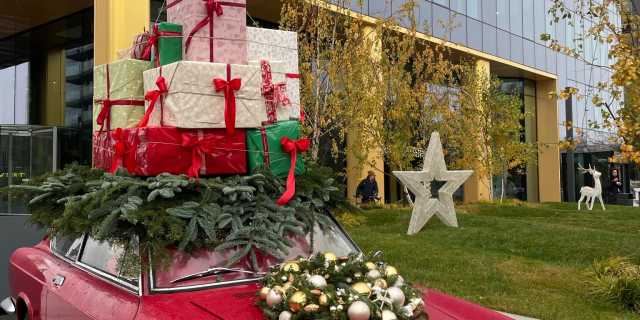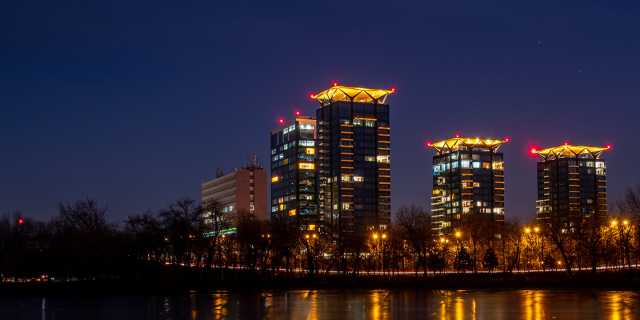Cișmigiu Park
Spread over about 16 hectares, Cișmigiu Park (or Cișmigiu Garden) has the status of the oldest park in Bucharest, but also one of the most romantic. Its story begins in 1779, with the arrangement of two drinking fountains to serve the city, at the request of ruler Alexandru Ipsilanti. From one of them, a large pond was formed, which in time was called Cișmegiului Lake. The one who came, in 1830, with the initiative to dry the pond and replace it with a public garden was General Pavel Kiseleff. Seven years later, the landscaping project was taken over by architect Wilhem Mayer, who had held the position of director of the Vienna Imperial Gardens, and was continued, after Mayer's unexpected death, by landscape architect Friedrich Rebhuhn. The park continued to receive new improvements, such as the installation of the fence and some wooden benches; a new pond was also dug. The inauguration was celebrated in 1854. The lake was first used as an ice rink in 1883 due to a natural frost but is now artificially landscaped every winter. Among the monuments that beautify the Cișmigiu Garden is the Writers' Roundabout, which includes a series of busts of the most important Romanian writers and the Sissi Stefanidi Spring. Also, in Cișmigiu we find the ruins of a place of worship, "La Cetate".
Carol I Park
Named, over time, Liberty Park and Filaret Park, after the hill on which it is located, Carol I Park was arranged at the request of Minister Ion N. Lahovari. He came up with this initiative out of the desire to create the space according to the development of the Romanian General Exhibition, organized in 1906 in honour of King Carol I, who celebrated 40 years of his reign. The works lasted six years, and the project was backed by landscape architect Édouard Redont. In the past, the park housed several exhibition pavilions and a small zoo. Later, several architectural and artistic elements were designed, including the water tower "Vlad Țepeș's Fortress", the sculptures "Sleeping Beauty" (transferred to Herăstrău Park) and "Giants", the Roman Arenas complex, the Zodiac Fountain, a mosque demolished in 1959 and the well-known Mausoleum. Over the years, the park's area has expanded from 36 to 41 hectares.
Herăstrău Park
One of the most frequented green areas in the city, King Mihai I Park of Romania (formerly called Carol II Park, National Park, Stalin IV Park, and, as it is widely known, Herăstrău Park) was inaugurated in 1936, in place of a former dried-up swamp. The architects responsible for the project were Ernest Pinard and Friedrich Rebhuhn (who had also completed the arrangement of Cișmigiu Park). Among the key moments that make up its history is the inauguration of the Village Museum (1936), the expansion of the area and its arrangement in its current format (1951), as well as the opening of the Summer Theater (1956). Among the main objectives of the park are the Japanese Garden, the Modura Fountain, and the Monument of the Founding Fathers of the European Union. Another aspect worth mentioning is the discovery of a Palaeolithic settlement on the shores of Lake Herăstrău, which led to the inclusion of the park in the National Archaeological Repertory. Currently, it covers an area of 187 hectares, being surrounded by an alley of almost 6 kilometres.
Floreasca Park
The history of Floreasca Park is one of radical transformation, and that's because in the past there was nothing here but a dirty ghetto, partially transformed into a landfill. It was closed in 1953, on the occasion of organizing a youth festival at the Floreasca Hall, and in its place was arranged, between 1961 and 1963, the current park, followed by the ice rink of the same name. Decorating items include a floral clock and a series of sculptures by artists Ion Vlasiu, George Apostu, and Victor Roman. In 2008, the park was redeveloped, and today it represents one of the most important points of interest of the urban community in the area, which includes the residents of One Mircea Eliade development (part of One Floreasca City ensemble).
Tineretului (Youth) Park
The architect Valentin Donose is responsible for the design of the largest park in Bucharest at present, with an area of approximately 200 hectares. The works in the south of the Capital were started in 1965 and lasted for nine years, the main goal being the establishment of a green oasis in an area suffocated by apartment buildings. The young Romanians contributed to the construction site, a first stage being the leveling of the land in order to be able to arrange the homonymous lake. Among the most important objectives built here is the National Children's Palace (formerly known as the Palace of the Pioneers and Falcons of the Fatherland), inaugurated in 1985, the Ioan Kunst Ghermănescu Hall (former Multipurpose Hall, opened in 1974), and The Ash crematorium, opened in 1923 and included on the list of historical monuments in 2011. Like Floreasca Park, this one was built on the site of a former landfill, which operated in an area formerly known as the Valley of Lamentation.
Alexandru Ioan Cuza Park
Completed in 1970, after five years of work, Al. I. Cuza Park has an area of about 85 hectares and includes the lake of natural origin Titan, on which five islands have been arranged. A landmark of the park is the Maramureș-style wooden church, which opened in 1996.
Data for this article was obtained from historia.ro, descopera.ro, capital.ro, cmpgb.ro și wikipedia.org.
More on our blog
- One Insider
- Real estate: past, present and future
- Layout and style
- Real estate education
- Free time in Bucharest
- Tourist attractions in Bucharest
- The neighborhoods of Bucharest
Read also










